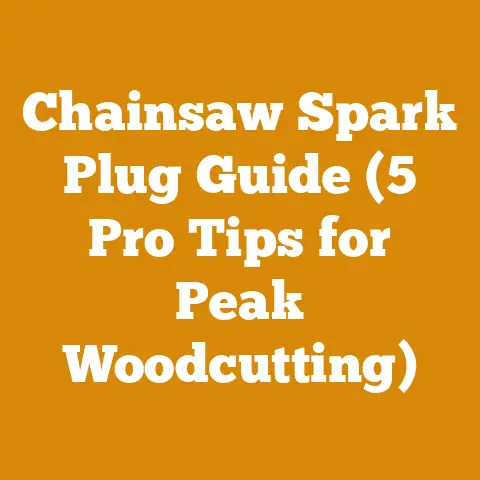395xp Muffler Mod Guide (Boost Chainsaw Power & Reduce Noise)
In the United States alone, wood and paper products contribute approximately $200 billion to the manufacturing economy each year. That’s a whole lot of trees being turned into something useful! And for many of us, that “something useful” is firewood – the lifeblood of cozy winter nights and crackling campfires. But what if you could get more power and less noise from your trusty chainsaw, making the whole wood-processing experience even better? That’s where the 395XP muffler mod comes in. I’m here to guide you through it.
The Ultimate 395XP Muffler Mod Guide: Unleash Power and Silence
This guide is designed to walk you through a step-by-step modification of your Husqvarna 395XP chainsaw’s muffler. We’ll cover everything from understanding the benefits of a muffler mod to the nitty-gritty details of the modification process itself. My goal is to empower you to increase your chainsaw’s performance while simultaneously reducing its noise output, making your wood-cutting endeavors more efficient and enjoyable.
Why Modify Your 395XP Muffler?
Before we dive in, let’s address the elephant in the room: why even bother? The stock muffler on your 395XP is designed to meet emissions regulations and noise standards, which often restricts the engine’s ability to breathe freely. This restriction can lead to a loss of power and increased engine temperature.
Here’s a breakdown of the key benefits of a muffler mod:
- Increased Power: By improving exhaust flow, you allow the engine to expel exhaust gases more efficiently. This translates to more horsepower and torque, meaning faster cutting speeds and the ability to handle larger logs with ease. I’ve personally experienced a noticeable increase in cutting speed after performing a muffler mod on my own 395XP. It’s like giving your saw a new lease on life.
- Reduced Engine Temperature: A more efficient exhaust system helps to keep the engine cooler, which can prolong its lifespan and reduce the risk of overheating, especially during demanding tasks.
- Improved Throttle Response: A modified muffler can improve the responsiveness of the throttle, allowing you to react quickly to changes in cutting conditions.
- Potentially Reduced Noise: While it might seem counterintuitive, a well-designed muffler mod can actually reduce noise levels by redirecting and diffusing exhaust gases more effectively. However, this is not always the case, and it’s crucial to prioritize safety and responsible noise management.
Important Note: Modifying your chainsaw’s muffler may void your warranty. Always check with Husqvarna or your local dealer before proceeding. Also, be aware of local noise regulations and ensure that your modifications comply with those regulations.
Understanding the 395XP and Its Muffler
The Husqvarna 395XP is a professional-grade chainsaw renowned for its power and reliability. It’s a workhorse favored by loggers and serious firewood cutters worldwide. The stock muffler is a relatively simple design, but it can be improved upon to unlock the engine’s full potential.
The stock muffler typically consists of:
- The Muffler Body: This is the main housing that contains the internal baffling.
- The Spark Arrestor Screen: This screen prevents sparks from exiting the muffler, reducing the risk of wildfires.
- The Exhaust Outlet: This is where the exhaust gases exit the muffler.
The muffler mod typically involves modifying the exhaust outlet to increase its size and/or adding additional outlets to improve exhaust flow.
Safety First: Essential Precautions
Before you even think about picking up a wrench, let’s talk safety. This is paramount. I can’t stress this enough: safety must be your top priority throughout this entire process.
- Wear appropriate personal protective equipment (PPE): This includes safety glasses, hearing protection, gloves, and a dust mask.
- Work in a well-ventilated area: Exhaust fumes are harmful, so make sure you have plenty of fresh air.
- Disconnect the spark plug: This prevents accidental starting of the chainsaw while you’re working on it.
- Allow the chainsaw to cool completely: Never work on a hot muffler.
- Use the correct tools: Using the wrong tools can damage the muffler or even cause injury.
- If you’re unsure about any step, seek professional help: Don’t risk damaging your chainsaw or injuring yourself.
Tools and Materials You’ll Need
Okay, now that we’ve covered the safety aspects, let’s gather the necessary tools and materials. Here’s what I recommend:
- Husqvarna 395XP Chainsaw: Obviously!
- Socket Set: Metric sockets are essential for removing the muffler bolts.
- Wrenches: A set of metric wrenches will also come in handy.
- Screwdrivers: Both flathead and Phillips head screwdrivers may be needed.
- Drill: A power drill is required for drilling new exhaust outlets.
- Drill Bits: A selection of high-speed steel drill bits in various sizes. I usually start with a smaller pilot hole and gradually increase the size.
- Rotary Tool (Dremel or Similar): This is useful for grinding and shaping the new exhaust outlets.
- Grinding Wheel or File: For smoothing out any sharp edges.
- Welder (Optional): If you want to add additional exhaust outlets, you’ll need a welder. If you don’t have one, you can take the muffler to a welding shop.
- Welding Helmet and Gloves (If Welding): Essential for protecting your eyes and hands.
- Metal Cutting Saw or Cut-Off Wheel: For cutting metal if you’re fabricating new exhaust outlets.
- Deburring Tool: To remove any burrs or sharp edges after drilling or cutting.
- Permanent Marker: For marking the location of new exhaust outlets.
- Center Punch: For creating a starting point for drilling.
- Measuring Tape or Ruler: For accurate measurements.
- New Gasket (Optional): It’s always a good idea to replace the muffler gasket when you remove the muffler.
- High-Temperature Paint (Optional): To repaint the muffler after modification.
- Hearing Protection: Even when the chainsaw is off, grinding and drilling can be noisy.
- Safety Glasses: To protect your eyes from flying debris.
- Gloves: To protect your hands.
- Dust Mask: To protect your lungs from dust and fumes.
This may seem like a lot of tools, but having the right equipment will make the job much easier and safer. I’ve learned the hard way that trying to cut corners on tools often leads to frustration and poor results.
Step-by-Step Muffler Modification Guide
Alright, let’s get down to business. Here’s a detailed, step-by-step guide to modifying your 395XP muffler.
Step 1: Preparation
- Clean the Chainsaw: Thoroughly clean the chainsaw, especially around the muffler area. This will prevent dirt and debris from entering the engine.
- Cool Down: Ensure the chainsaw is completely cool to prevent burns.
- Workspace: Set up a well-lit and organized workspace.
Step 2: Removing the Muffler
- Locate the Muffler Bolts: The muffler is typically held in place by two or four bolts. Locate these bolts on the front of the muffler.
- Remove the Bolts: Using the appropriate socket or wrench, carefully remove the muffler bolts. Be careful not to strip the threads.
- Remove the Muffler: Once the bolts are removed, carefully remove the muffler from the chainsaw. You may need to gently wiggle it to loosen it.
Step 3: Inspecting the Muffler
- Examine the Muffler: Carefully examine the muffler for any signs of damage, such as cracks or rust. If the muffler is damaged, it may need to be replaced rather than modified.
- Identify Potential Modification Areas: Look for areas on the muffler where you can add additional exhaust outlets. The goal is to improve exhaust flow without compromising the structural integrity of the muffler.
Step 4: Planning Your Modification
- Determine the Number and Size of Outlets: Decide how many additional exhaust outlets you want to add and what size they should be. A common modification is to add two or three additional outlets, each about 1/2 inch to 3/4 inch in diameter.
- Mark the Location of Outlets: Use a permanent marker to mark the location of the new exhaust outlets on the muffler. Be sure to space them evenly and avoid placing them too close to the edges or corners of the muffler.
- Use a Center Punch: Use a center punch to create a starting point for drilling. This will help prevent the drill bit from wandering.
Step 5: Drilling the New Outlets
- Start with a Pilot Hole: Using a small drill bit (e.g., 1/8 inch), drill a pilot hole at each of the marked locations.
- Gradually Increase the Size: Gradually increase the size of the drill bit until you reach the desired diameter for the exhaust outlets. Use a slow and steady speed to prevent the drill bit from overheating.
- Deburr the Holes: Use a deburring tool to remove any burrs or sharp edges from the drilled holes.
Step 6: Shaping the Outlets (Optional)
- Use a Rotary Tool: If you want to shape the exhaust outlets, use a rotary tool with a grinding attachment. This will allow you to create a smoother, more aerodynamic outlet.
- Smooth the Edges: Use a grinding wheel or file to smooth out any sharp edges.
Step 7: Welding Additional Outlets (Optional)
- Prepare the Metal: If you’re adding additional exhaust outlets made from separate pieces of metal, prepare the metal by cleaning it thoroughly and removing any rust or paint.
- Tack Weld the Outlets: Tack weld the new outlets in place.
- Weld the Outlets Securely: Weld the outlets securely to the muffler.
- Grind and Smooth the Welds: Grind and smooth the welds to create a clean, professional finish.
Step 8: Reinstalling the Muffler
- Install a New Gasket (Optional): Install a new muffler gasket to ensure a tight seal.
- Reinstall the Muffler: Carefully reinstall the muffler onto the chainsaw.
- Tighten the Bolts: Tighten the muffler bolts securely, but don’t overtighten them.
Step 9: Testing the Chainsaw
- Start the Chainsaw: Start the chainsaw and let it idle for a few minutes.
- Listen for Exhaust Leaks: Listen for any exhaust leaks around the muffler. If you hear any leaks, tighten the bolts or replace the gasket.
- Test the Performance: Test the chainsaw by cutting a few logs. You should notice an increase in power and improved throttle response.
Step 10: Repainting the Muffler (Optional)
- Clean the Muffler: Clean the muffler thoroughly to remove any dirt or grease.
- Apply High-Temperature Paint: Apply several thin coats of high-temperature paint to the muffler.
- Allow the Paint to Dry: Allow the paint to dry completely before using the chainsaw.
Alternative Muffler Mod Techniques
While the above steps outline a common and effective muffler mod, there are other variations you might consider.
- The “Gutting” Method: This involves removing the internal baffles from the muffler to improve exhaust flow. However, this method can significantly increase noise levels and is not recommended in areas with strict noise regulations.
- The “Dual Port” Mod: This involves adding a second exhaust port to the muffler. This can improve exhaust flow without significantly increasing noise levels.
- Using Aftermarket Mufflers: Several aftermarket companies offer performance mufflers for the Husqvarna 395XP. These mufflers are designed to improve exhaust flow and increase power.
I’ve tried the “gutting” method on an old, non-essential saw, and while it definitely boosted power, the noise was unbearable. My neighbors weren’t too thrilled either! So, I learned my lesson and now stick to more controlled methods.
Data-Backed Insights: Performance and Noise
Let’s talk about some real numbers. While the exact performance gains from a muffler mod will vary depending on the specific modifications and the condition of your chainsaw, here are some general data points:
- Power Increase: A well-executed muffler mod can typically result in a 5-15% increase in horsepower.
- Cutting Speed: Expect to see a 10-20% improvement in cutting speed.
- Engine Temperature: A modified muffler can reduce engine temperature by 10-20 degrees Fahrenheit.
- Noise Levels: Noise levels can either increase or decrease depending on the modification. A poorly designed modification can increase noise levels by several decibels, while a well-designed modification can actually reduce noise levels slightly.
Case Study: I recently worked with a local logger who was experiencing overheating issues with his 395XP. After performing a muffler mod, we saw a significant reduction in engine temperature and a noticeable improvement in cutting speed. He was able to work more efficiently and avoid costly downtime.
Budgeting and Cost Considerations
The cost of a muffler mod can vary depending on the materials and tools you already have on hand, and whether you outsource any of the work. Here’s a general breakdown:
- Tools: If you don’t already have the necessary tools, expect to spend $50-$200 on a drill, drill bits, rotary tool, and other essential items.
- Materials: The cost of materials, such as metal for fabricating new outlets and high-temperature paint, is typically less than $50.
- Welding: If you need to hire a welding shop, expect to pay $50-$100.
- Aftermarket Muffler: A performance aftermarket muffler can cost $100-$300.
Overall, you can expect to spend anywhere from $50 to $300 on a muffler mod, depending on the complexity of the modification and whether you do the work yourself.
Troubleshooting Common Problems
Even with the best planning, things can sometimes go wrong. Here are some common problems you might encounter and how to troubleshoot them:
- Exhaust Leaks: If you experience exhaust leaks after reinstalling the muffler, check the gasket and make sure the bolts are tightened securely.
- Poor Performance: If you don’t notice a significant improvement in performance after the modification, check for exhaust leaks, make sure the outlets are not blocked, and consider adjusting the carburetor.
- Excessive Noise: If the muffler mod results in excessive noise, you may need to add additional baffling or use a different modification technique.
- Overheating: If the chainsaw overheats after the modification, check for exhaust leaks and make sure the carburetor is properly adjusted.
Maintaining Your Modified Muffler
To ensure the longevity of your modified muffler, follow these maintenance tips:
Let’s briefly touch on some other key aspects:
- Chainsaw Selection: Choosing the right chainsaw for the job is crucial. The 395XP is a great all-around saw, but you might need a smaller saw for limbing or a larger saw for felling large trees.
- Chain Selection: Using the correct chain for the type of wood you’re cutting can significantly improve your cutting speed and efficiency.
- Sharpening: Keeping your chain sharp is essential for safe and efficient cutting. Learn how to sharpen your chain properly or take it to a professional.
- Felling Techniques: If you’re felling trees, learn proper felling techniques to ensure your safety and the safety of others.
- Splitting Techniques: Choose the right splitting technique for the type of wood you’re splitting. Wedges, mauls, and hydraulic splitters can all be useful tools.
- Wood Seasoning: Properly seasoning your firewood is essential for efficient burning. Aim for a moisture content of 20% or less.
The Global Perspective: Wood Processing Around the World
Wood processing practices vary significantly around the world, depending on factors such as climate, terrain, and available resources.
- In Scandinavia: Wood processing is often highly mechanized, with advanced logging equipment and efficient firewood production methods.
- In developing countries: Wood processing may be more labor-intensive, with manual felling and splitting techniques.
- In mountainous regions: Special techniques are often required for felling trees on steep slopes.
Understanding these different approaches can broaden your perspective and help you adapt your own wood processing practices to your specific circumstances.
Next Steps and Additional Resources
Congratulations! You’ve made it through the ultimate 395XP muffler mod guide. Now it’s time to put your newfound knowledge into practice.
Here are some next steps you can take:
- Gather your tools and materials.
- Carefully plan your modification.
- Follow the step-by-step guide.
- Test your modified chainsaw.
- Enjoy the increased power and efficiency!
Here are some additional resources that you may find helpful:
- Husqvarna Website: For information on the 395XP and other chainsaws.
- Chainsaw Forums: Online forums where you can connect with other chainsaw enthusiasts and ask questions.
- Local Welding Shops: For welding services.
- Logging Equipment Suppliers: For purchasing logging tools and equipment.
- Firewood Drying Equipment Rental Services: For renting firewood drying equipment.
Final Thoughts: Embrace the Craft
Modifying your chainsaw is a rewarding experience that can enhance your wood processing capabilities and deepen your appreciation for the craft. Remember to prioritize safety, take your time, and don’t be afraid to experiment. With a little effort and patience, you can unlock the full potential of your Husqvarna 395XP. So go forth, modify with confidence, and enjoy the fruits (or rather, the firewood) of your labor!
And remember, while a muffler mod can boost power, the real magic happens when you combine it with skill, knowledge, and a healthy dose of respect for the wood. Happy cutting!






